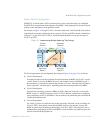BLADEOS 6.5.2 Application Guide
BMD00220, October 2010 Chapter 8: Spanning Tree Protocols 119
Creating a VLAN
When you create a VLAN, that VLAN automatically belongs to STG 1, the default STG. To
place the VLAN in a different STG, follow these steps:
Create the VLAN.
Add the VLAN to an existing STG.
The VLAN is automatically removed from its old STG before being placed into the new STG.
Each VLANs must be contained within a single STG; a VLAN cannot span multiple STGs. By
confining VLANs within a single STG, you avoid problems with Spanning Tree blocking ports
and causing a loss of connectivity within the VLAN. When a VLAN spans multiple switches, it
is recommended that the VLAN remain within the same STG (be assigned the same STG ID)
across all the switches.
If ports are tagged, all trunked ports can belong to multiple STGs.
A port cannot be directly added to an STG. The port must first be added to a VLAN, and that
VLAN added to the desired STG.
Rules for VLAN Tagged Ports
Tagged ports can belong to more than one STG, but untagged ports can belong to only one STG.
When a tagged port belongs to more than one STG, the egress BPDUs are tagged to distinguish
the BPDUs of one STG from those of another STG.


















